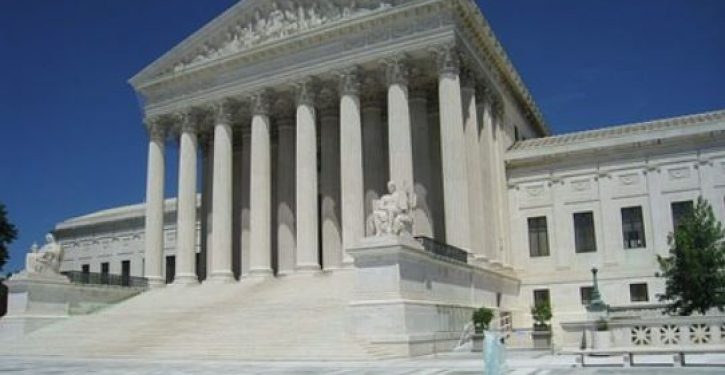
Prior to this week, the definition of “wetland” under the Clean Water Act was so broad (in the eyes of some judges) that the Environmental Protection Agency could claim that desert land was a wetland, by pointing to water that flowed from it, over other parcels of land, to eventually reach a waterway. That is because courts deferred to the EPA about what a wetland is, and water always flows downhill. But yesterday, the Supreme Court rejected the EPA’s interpretation, ruling that a plot of land isn’t a wetland merely because water in it later ends up in a waterway, if the plot isn’t adjoining the waterway. As a result, notes Iain Murray of the Competitive Enterprise Institute, “Deserts will no longer be classified as wetlands. This is a major victory for common sense as opposed to expansive reading of the law and a defeat for bureaucrats.” Moreover, notes Mario Loyola, after yesterday’s ruling, “EPA won’t be able to conduct air assaults on young married couples and hit them with industrial $40k/day fines for filling in a ditch on their new property to lay the foundation for their new home.”
Yesterday, in Sackett v. Environmental Protection Agency, the Supreme Court narrowed the scope of federal regulatory authority under the Clean Water Act. The justices were unanimous in rejecting the U.S. Court of Appeals for the Ninth Circuit’s expansive interpretation of what a wetland is, and in rejecting former Supreme Court Justice Kennedy’s “significant nexus” test for Clean Water Act jurisdiction (which defines most of the U.S. as a wetland, although not as much as the “hydrological connection” test favored by the Obama administration and past liberal Supreme Court justices, which allows the EPA to treat virtually all land in the U.S. as a wetland, because water flows downhill).
But the justices split 5-4 on how to interpret the Clean Water Act and the extent to which Congress empowered the EPA to regulate wetlands as part of “the waters of the United States” referred to in the Clean Water Act.
Justice Alito wrote a opinion for the Court’s majority, joined by the Chief Justice and Justices Thomas, Gorsuch, and Barrett. His opinion embraces a conservative Supreme Court justice’s narrow interpretation announced in an earlier Supreme Court case, Rapanos v. United States. His majority opinion states:
the Act applies to “navigable waters,” which had a well-established meaning at the time of the CWA’s enactment. But the CWA complicates matters by proceeding to define “navigable waters” as “the waters of the United States,”§1362(7), which was decidedly not a well-known term of art.This frustrating drafting choice has led to decades of litigation, but we must try to make sense of the terms Congress chose to adopt. And for the reasons explained below, we conclude that the Rapanos plurality was correct: the CWA’s use of “waters” encompasses “only those relatively permanent, standing or continuously flowing bodies of water’ forming geographic[al] features’ that are described in ordinary parlance as ‘streams, oceans, rivers, and lakes.'”
Justice Alito says this means wetlands that have a continuous surface water connection or are directly adjoining jurisdictional waters may be regulated as part of the waters of the United States, but those wetlands that are physically “separate” from such waters may not be, even if they are “adjacent.” His opinion explains:
In sum, we hold that the CWA extends to only those wetlands that are “as a practical matter indistinguishable from waters of the United States.” Rapanos, 547 U. S., at 755 (plurality opinion) (emphasis deleted). This requires the party asserting jurisdiction over adjacent wetlands to establish “first, that the adjacent [body of water constitutes] . . . ‘water[s] of the United States,’ (i.e., a relatively permanent body of water connected to traditional interstate navigable waters); and second, that the wetland has a continuous surface connection with that water, making it difficult to determine where the ‘water’ ends and the ‘wetland’ begins.” Id., at 742.
Justice Clarence Thomas wrote a concurring opinion saying that maybe federal regulatory authority should shrink even further. In an opinion joined by Justice Neil Gorsuch he writes:
like the Rapanos plurality before it, the Court focuses only on the term “waters”; it does not determine the extent to which the CWA’s other jurisdictional terms—”navigable” and “of the United States”—limit the reach of the statute. Ante, at 14–18; Rapanos, 547 U. S., at 731 (plurality opinion). I write separately to pick up where the court leaves off.
He then observes that federal regulatory authority over navigable waters is limited by the fact that it is pursuant to the Constitution’s commerce clause, which only allows Congress to restrict activities that substantially affect interstate commerce, and thus its reach should be read narrowly as explained in the Supreme Court’s decision in The Daniel Ball (1871).
The text of the CWA thus reflects the traditional balance between federal and state authority over navigable waters, as set out by The Daniel Ball. It would be strange indeed if Congress sought to effect a fundamental transformation of federal jurisdiction over water through phrases that had been in use to describe the traditional scope of that jurisdiction for well over a century and that carried a well-understood meaning.
By contrast, Justice Kavanaugh, writing for himself and progressive justices, took issue with the majority’s narrow interpretation of the scope of federal power, especially about federal power over wetlands “adjacent” to otherwise regulable waters.
I agree with the Court’s reversal of the Ninth Circuit. In particular, I agree with the Court’s decision not to adopt the “significant nexus” test for determining whether a wetland is covered under the Act. And I agree with the Court’s bottom-line judgment that the wetlands on the Sacketts property are not covered by the Act and are therefore not subject to permitting requirements.
I write separately because I respectfully disagree with the Court’s new test for assessing when wetlands are covered by the Clean Water Act. The Court concludes that wetlands are covered by the Act only when the wetlands have a “continuous surface connection” to waters of the United States—that is, when the wetlands are “adjoining” covered waters. Ante, at 20, 22 (internal quotation marks omitted). In my view, the Court’s “continuous surface connection” test departs from the statutory text, from 45 years of consistent agency practice, and from this Court’s precedents. The Court’s test narrows the Clean Water Act’s coverage of “adjacent” wetlands to mean only “adjoining” wetlands. But “adjacent” and “adjoining” have distinct meanings: Adjoining wetlands are contiguous to or bordering a covered water, whereas adjacent wetlands include both (i) those wetlands contiguous to or bordering a covered water, and (ii) wetlands separated from a covered water only by a man-made dike or barrier, natural river berm, beach dune, or the like. By narrowing the Act’s coverage of wetlands to only adjoining wetlands, the Court’s new test will leave some long-regulated adjacent wetlands no longer covered by the Clean Water Act, with significant repercussions for water quality and flood control throughout the United States.
Justice Kagan’s separate opinion harps on the same subjects, and criticizes the majority opinion for not reading federal regulatory power more broadly in light of the Clean Water Act’s reference to adjacency. Her opinion says:
Like JUSTICE KAVANAUGH, “I would stick to the text.” Post, at 14 (opinion concurring in judgment). As he explains in the principal concurrence, our normal method of construing statutes identifies which wetlands the Clean Water Act covers—and the answer provided exceeds what the Court says today. Because the Act covers “the waters of the United States,” and those waters “includ[e]” all wetlands”adjacent” to other covered waters, the Act extends to those “adjacent” wetlands. 33 U. S. C. §§1362(7), 1344(g)(1). And in ordinary language, one thing is adjacent to another not only when it is touching, but also when it is nearby. See post, at 4–5 (quoting multiple dictionaries). So, for example, one house is adjacent to another even when a stretch of grass and a picket fence separate the two. As applied here, that means—as the EPA and Army Corps have recognized for almost half a century—that a wetland comes within theAct if (i) it is “contiguous to or bordering a covered water, or (ii) if [it] is separated from a covered water only by a man-made dike or barrier, natural river berm, beach dune, or the like.” Post, at 14 (emphasis in original). In excluding allthe wetlands in category (ii), the majority’s “‘continuous surface connection’ test disregards the ordinary meaning of more precisely, narrows the scope of—the statute Congress drafted.
While this Supreme Court ruling narrows the definition of “the waters of the United States” for purposes of the entire Clean Water Act, the ruling won’t have a big impact on some other traditional pollution control efforts. That’s because the Supreme Court’s earlier decision in Maui v. Hawaii Wildlife Fund upheld an expansive interpretation of what constitutes a “discharge” of pollutants, such that some activities that result in the contamination of regulable waters may be subject to regulation even if they occur on lands that are not themselves wetlands as defined by the Clean Water Act.



